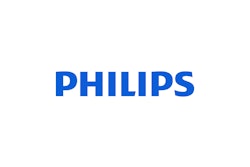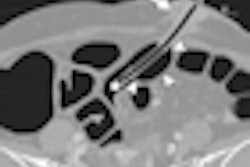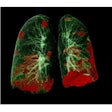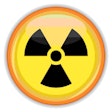Add post-colectomy surveillance to virtual colonoscopy’s list of indications. Researchers from the General Hospital of Athens "G Gennimatas" and the University of Athens used the virtual exam to screen for disease recurrence in individuals who have undergone temporary or permanent colectomy, and found that it could be easily adapted for cancer staging.
Conventional colonoscopy suffers from a high rate of false-negatives, failure to complete the exam in 15%-20% of patients, and the inability to use it for staging cancer, said Dr. Politimi Leonardou at the 2004 European Congress of Radiology in Vienna.
"The purpose of our study was the evaluation of CT colonography (virtual colonoscopy) as a screening method to diagnose disease recurrence in patients treated with colectomy for cancer," she said.
The study examined 53 patients from 12 to 48 months post-colectomy. Forty-four of the patients (31 men and 13 women, mean age 43) had a partial colectomy, while an additional nine patients (seven men and two women, mean age 48 years) had a complete colectomy.
Following a 24-hour purgative bowel cleansing, patients were insufflated manually with room air to tolerance, through the colostomy opening and the rectum, as applicable. They also received intravenous Buscopan as a spasmolytic agent. All patients underwent prone and supine imaging on a single-slice CT scanner (Tomoscan SR 7000, Philips Medical Systems, Andover, MA) using 5-mm slice thickness, 2.5-mm reconstruction, 10-mm/sec. table speed.
Between prone and supine scanning, patients also received an iodinated contrast agent intravenously to facilitate the search for metastases, particularly in the liver, Leonardou said. The CT images were transferred to a Philips EasyVision workstation for postprocessing, 3D rendering and endoluminal viewing. The patients subsequently underwent conventional colonoscopy, which was incomplete in six patients. Another two patients refused the conventional exam, but tolerated VC quite well, she said.
"Recurrence was detected in four patients, almost 8%, and compared to conventional endoscopy," she said. "Contrast-enhanced CT showed no mets of the liver, both techniques detected two small polyps in the descending colon (in one patient), and biopsy was performed and was negative for cancer," she said. Each technique also found two masses (one rectosigmoid) that were proven malignant at biopsy.
However, virtual colonoscopy missed a rectal mass in one case with a very low anterior resection, where it was growing close to the rectum, and the mass was found in conventional colonoscopy. No liver metastases were found.
"The advantage of (virtual colonoscopy) is that this is well tolerated in all patients," Leonardou said. "And especially the colostomy (cases), which are the most difficult ones to deal with after a colectomy. The entire colon can be examined because the air is redistributed easily, and there is disease staging because of extracolonic viewing."
As for drawbacks, the cost of VC is still relatively high, she said, and VC cannot be used for invasive maneuvers such as biopsy or polypectomy.
By Eric BarnesAuntMinnie.com staff writer
April 21, 2004
Related Reading
Enhanced MRI helps diagnose pediatric inflammatory bowel disease, March 22, 2004
Capsule endoscopy fares well in small bowel versus CT, barium enema, January 14, 2004
Copyright © 2004 AuntMinnie.com



















